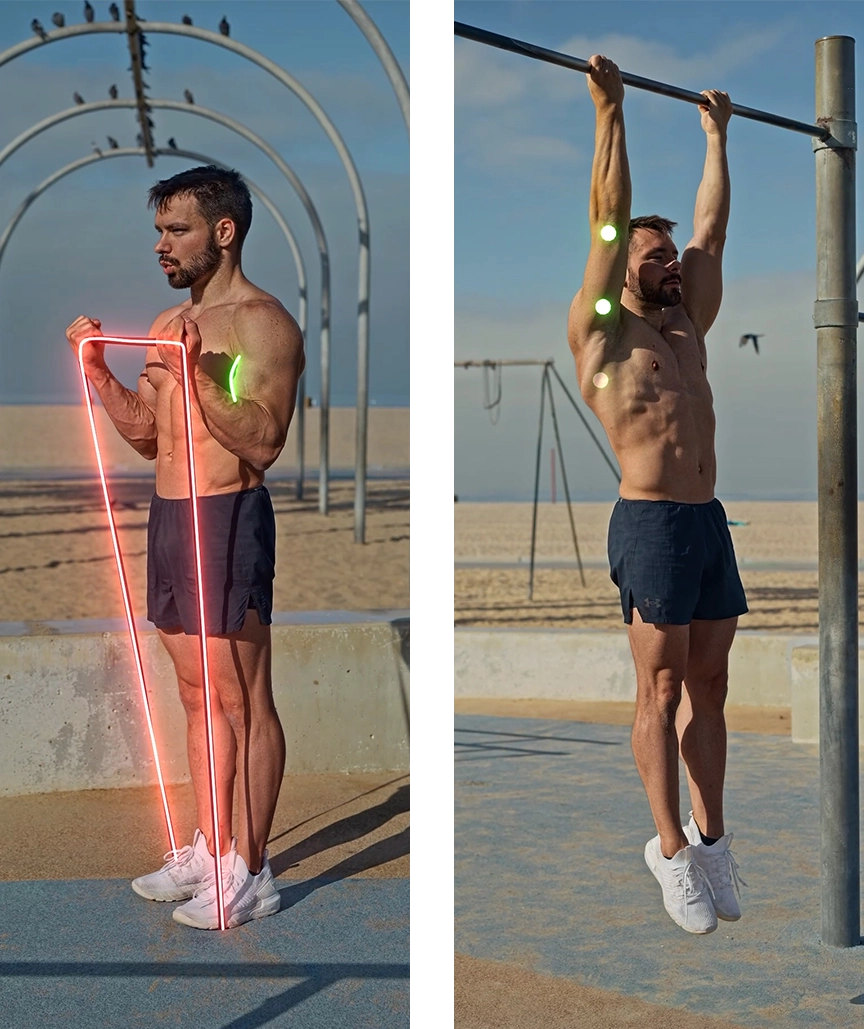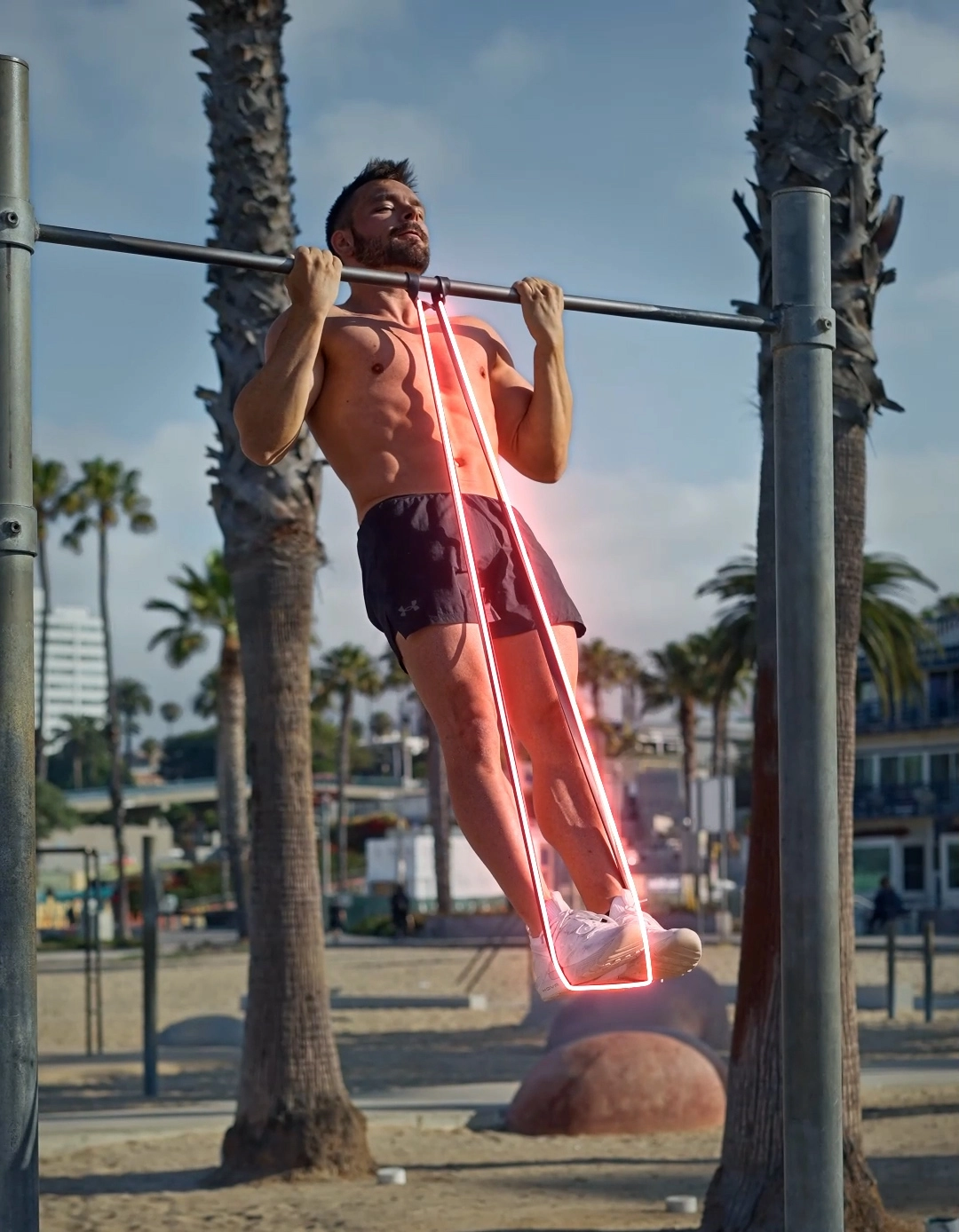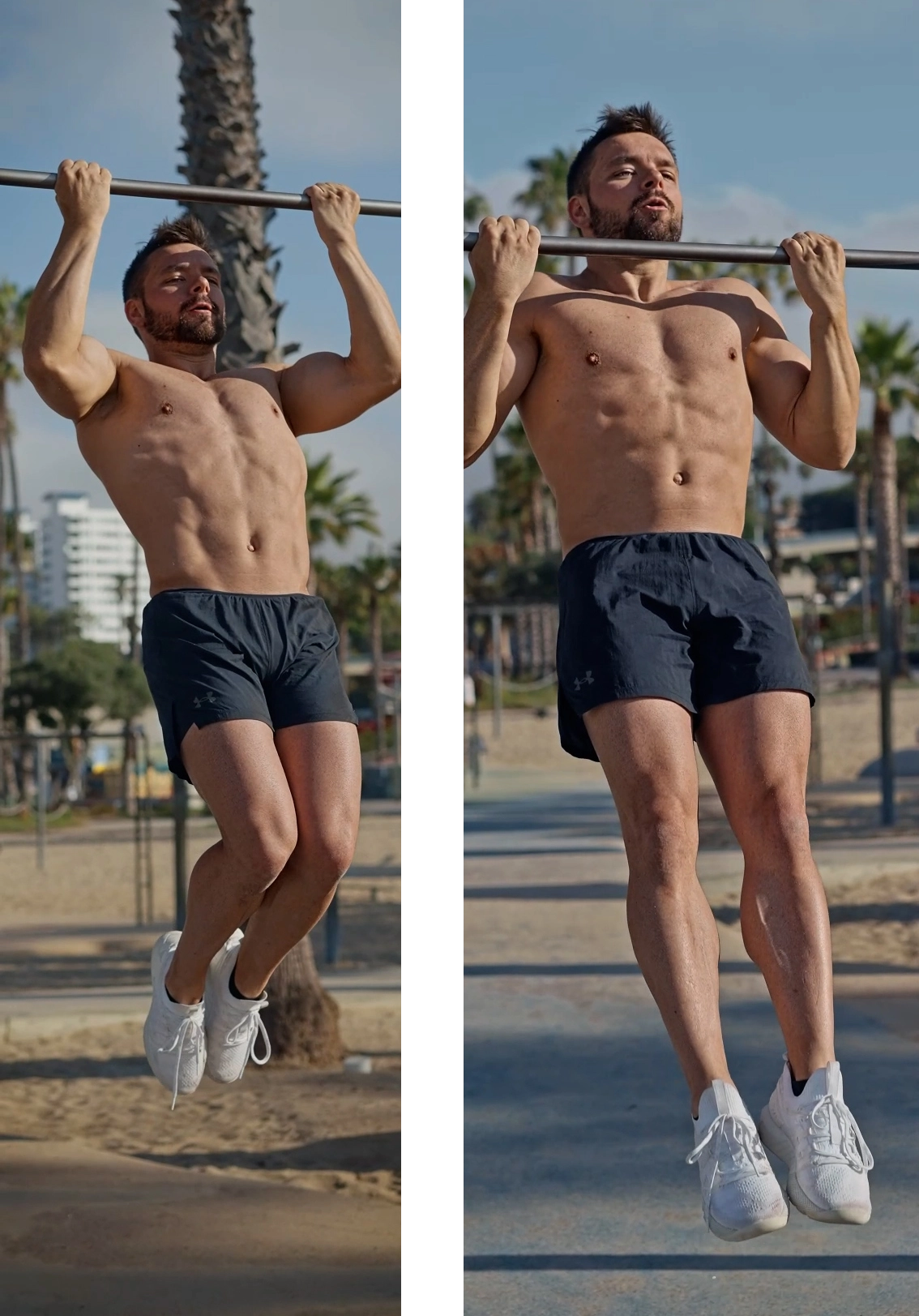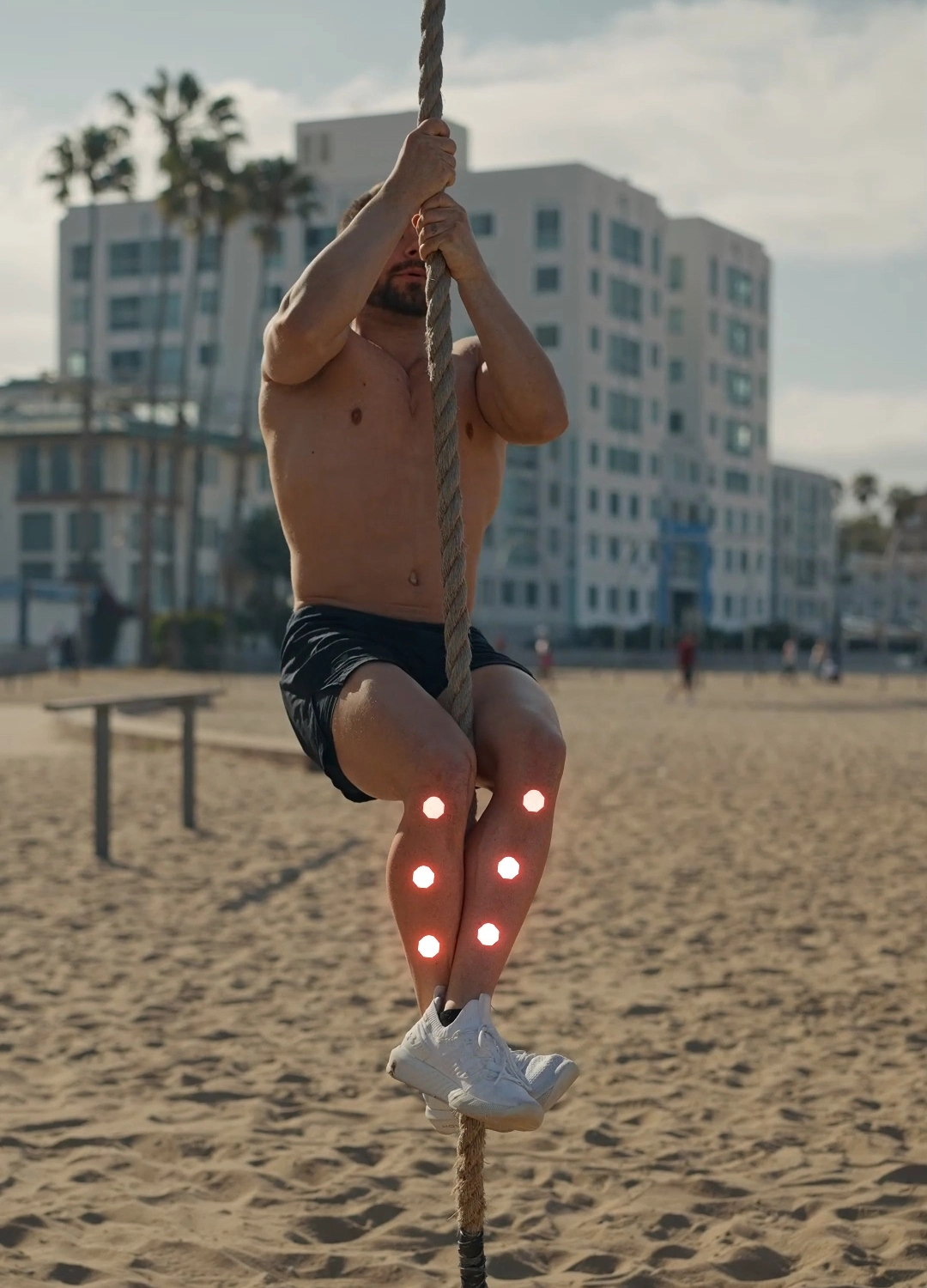First Pull Up - Essential Tips
Pull ups are an essential bodyweight fitness movement. More than just an addition to your workouts pull ups represent a reason to work out for. They work your entire back, biceps, forearms, grip, lats and core. Additionally, the hero in any action movie looks oh so cool when he pulls himself back up into the crashing airplane.
So as you can tell: Pull ups are life. Unfortunately, doing something new is never easy and if you can not pull up yet you will have a hard time even imagining how you are supposed to yank your body up and the chin on top of the bar. Luckily for you, I’ve helped plenty of clients and athletes achieve their first pull up. So, down your pre workout meal and drink, get chalked up and let’s get to work.
Muscles involved in the Pull Up
The easy answer is that all the pulling muscles are involved and with that the arms, shoulders and back chain. The forearms are working hard gripping the bar or rings and your core is working as a stabilizer for your entire body.
In order to be able to train specifically and in order to truly understand which part of our body is too weak and holding us back from full pull up success we need to get a bit deeper and analyze what is really happening. Once we know what kind of movements our joints go through we can isolate said movements and build the necessary strength.
Starting at the top we are holding on for our dear lives. We need to have enough grip strength. Your flexor digitorum profundis (FDP) and flexor pollicis longus (FPL) are located in the forearms and responsible for your grip. These muscles will get stronger in every single pulling workout.
Moving down the next anatomical movement involved is Elbow Flexion. The Brachialis, Biceps, brachioradialis are doing the work here.
Next up we have the shoulder. Depending on how you grip the bar the movement performed by your shoulders can vary. In a regular chin up your shoulder is extension through the latissimus dorsi, teres major and minor and posterior deltoid muscles.
Additionally we have scapula depression forced by the lower traps to hold your shoulder joint in place and as mentioned above the core and legs are responsible to hold the entire body in place.
How to Start Pull Ups for Beginners
It is always hard to start something new. Problem with starting pull ups is that you might be hanging from the bar and nothing is moving at all. You are not able to make anything work. This is of course quite discouraging. Yet, this is absolutely no reason to panic. Many people start at this point and anyone willing to put in the work made it well past this.
Start from 0
First thing is to look at all the different muscles involved and to prep them separately. Just above I broke down all anatomical movements of the pull up and which muscles are responsible for each. The main ones are scapula pull downs, biceps curls and shoulder extension. Focus on those 3 movements in progressions and get to work. Identify your muscles, wake them up and tell them it is time to grow. Aim for 2-3 workouts per week with 3-5 sets for each muscle group to total at around 10 sets weekly during the first 2-4 weeks of training.

Apply minimal pressure
Once muscles have been found and the body is ready to work it is now time to put it together. Learning to pull up is not only about building strength but also about building coordination.
The idea now is to the whole movement but with minimal pressure so we can really focus on form and joint movements. Start with elastic pull downs. Alternatively you can also do these at the gym with a cable pully system. Make sure to practice the whole range of movement. Lock your elbows on top yet keep your scapula depressed to protect yourself from injuries.
Additionally, start adding sitting or leg assisted pull ups into the mix. These are great as you have most of your weight on the feet and you can really decide how much weight you want to place in your hands. This gives you high levels of flexibility to adjust level towards your daily form but also makes consistency a bit more difficult as you do not have an adequate way of measuring your progress.

Assisted Pull Ups
This is the big one! Band or even machine assisted pull ups at the gym are probably the best pull up progression there is. By using different strength of bands you can adjust difficulty and provide constant overload and growth towards your first pull up. Additionally, you will be able to do multiple reps allowing you to actually train the muscles and not just to overload the joints and tendons.
Again, just as always make sure to work the entire movement. Form is always key. 1 super clean pull up is significantly more impressive and especially much healthier than 20 wild ones! Do not ever forget that!

Slow Negatives
Focusing just on the eccentric part of movements works with pretty much anything. No matter what you are trying to learn or to improve you will be able to build enough strength with this. Growing up doing gymnastics or training to become a circus performer we didn’t always know how to do things correctly and how to learn new drills. When ever it was something that could be solved with more strength we would always take the same approach: Lower down as slowly as possible. Eventually you will feel control all the way through and you will be able to press or pull back up half way through.
Same with your pull ups. Either jump or climb up to get your chin on top of the bar. Now resist and lower down as slowly as possible. You will probably find a moment where you feel as if you are about to lose control. We call this moment the “sticking point”. In this moment resist. Do not think of lowering anymore. Give it your everything and try to freeze in the position. Gravity will take care of the rest!
Aim to take 10 seconds or even more on the way down. You can even include multiple static holds whilst lowering.

Pinpoint your particular weak spot
Training, failing and analyzing is key for success. The pull up basically consists of 2 parts: the bottom part when you first engage and bend the elbows and the top half when you pull the elbows down as far as possible to truly get the chin on top.
Both parts are challenging and both might need some extra work. While this is for athletes who already have some experience with pull ups a great way to train even more specifically for your pull up is to work only the top or the bottom part of the movement. Train half reps to build strength in the specific range that you are missing.

Switch it up
You do not have to train pull ups exclusively to get good at pull ups. The goal in general should actually not be to get good at the particular movement but actually to improve all over arm, back and pulling strength. When trying to make significant gains we have to work rather specific but with this comes the danger to not actually get stronger but just better at a specific movement.
This is why it is essential to train a wider range and variety of movements. Change your pull up training up and include rope climbs, rowing and even swimming workouts in your routine.
Keep your body challenged by introducing fresh impulses and challenges on a regular basis to create a strong and well rounded physic.

Finish your workouts strong
After doing your full body compound drills it is always great to finish with specific isolation work. For this use the same principle as you did when building your very first workout. Analyze what kind of anatomical movements are involved in the pull and which muscles are responsible for them. Now isolate those muscles and squeeze out what ever is left.
Finish your pull up workouts with 2-3 sets of scapula pull ups, biceps curls & lat push downs. You can use drop sets here, super sets or any other common weight lifting/ body building protocol.
Pull Up Program for Beginners
No matter you current pull up level in order to improve your pull ups you have to get stronger. In order to get stronger you need to follow a few rules of thumb. If you are able to build your weekly workouts around them and you are motivated enough to push hard you will get your pull up. There is absolutely no question here!
Train 2-3 times per week. Keep at least 1 day off between each workout for 1 specific body part.
Keep workouts short and efficient. Don’t hang out at the gym for hours. Instead get in, do your workout and get out. From my experience not even most professional athletes can not push very intensely for more than 45min. Keep it sweet and short!
Structure your workouts. Start with a good warm up. Break a sweat and include injury prevention work. From there do a few sets of light coordination drills. This is the moment when you have the most energy in your workout and you are the warmest so get started with your hardest progression. Finish your workouts with isolation work focusing on limiting points.
Keep rep count high. Do not train your 1 rep max. You would not do this at the gym with the weights so don’t do it with your body. If you can not do at least 4 reps of the exercise take a step back and work an easier progression. Stay injury free to be able to make constant progress.
Listen to your body. No coach or routine will ever know your body better than you do. Yes, push yourself but also listen to your body. Feeling tired? Take an extra rest day or just do half of the planned sets.
Do not try to fix something if it ain’t broken. No program is ever truly perfect and we often tend to look for a new program to maximize gains. As long as you are improving the program is working well. Even if you hit a plateau it is ok to stick to the program for a while. Small plateaus are part of training. The better you get the harder you will have to push and the slower you will improve.
Nutrition and recovery
To get better at pull ups you have to get stronger.
To get stronger you have to build muscles.
The foundation for muscle growth is laid during your workouts. Every rep of every set tears the muscle a tiny bit. In between your workouts these micro tears grow back together. Assuming that you are providing your body with adequate amounts of protein these tears will grow back together stronger and ultimately you get better at pull ups.
Over time your body gets better at this recovery process. As a general rule of thumb I recommend to take 1 full day off in between training the same muscle group. If you were only to train pulling work you could for example train Monday, Wednesday and Fridays. Tuesdays & Thursdays are great for Push and leg work as these are different muscle groups.
It is also ok to rest longer than just 1 full day. If your workout is very big or you have not been training for a long time your body will need more time to recover.
Chalk! The secret weapon
Magnesium is the obvious and not-so-secret-secret of gymnastics and I absolutely recommend to take advantage of it. By using chalk on your hands when doing pull ups your grip improves significantly. Your hands will somewhat stick to the bar.
This comes with 2 advantages. Number 1 you do not have to invest as much energy into gripping the bar. Less power spend there means your body has more power available to put into the actual pull up movement.
Secondly, with your hands not sliding on the bar you have more control over your body on the bar. Every impulse has a counter reaction. If you are standing on 1 foot and you lift your arm out to the side you can feel the weight change inside of the foot as the impulse travels through your body into the constant, the floor. Same in your pull up. If you engage your lats and biceps the impulse travels through your body until it hits the bar. If your hands rotate on the bar parts of the energy of this impulse are wasted on this movement. With chalk your hands won’t rotate and 100% of the energy invested in the pull up actually goes towards the pull up. Try it. You will feel the difference!
Pull Ups VS. Chin Ups
This is a question that I get a lot and understandably so. Whilst both movements are rather similar there are a few significant differences between the 2.
Generally I would recommend to start training the chin up first. The suspinated grip allows for greater biceps engagement allowing you to use the biceps over other, smaller muscles in your pulling chain. It is much easier to stay clean during the chin ups and you will have an easier time really getting the chin on top of the bar. Chin ups are not all great though. To lock the elbows at the bottom position of the chin up one requires a minimum amount of shoulder and wrist flexibility. If this one is not met elbow injuries can occur. If you feel pain in your elbows you should stop your set and change your grip accordingly.
Pull Ups are using a pronated grip and are therefor easy in the bottom position as no flexibility is required. If you are very stiff these are for you! During the pull up movement the athlete can place the hands wider and slightly arch the back for greater back engagement and increased difficulty. Due to the hand position one has to use the brachioradialis over the biceps which is harder as the muscle is smaller. Pull ups are great for muscle ups and are therefore a favorite for many. While it is common to load pull up training with exterior weight for increased difficulty it is harder to stay clean and not to swing.
A great compromise to get started are neutral grip pull ups as you get many advantages of the chin up without the flexibility requirements. My personal favorite are ring pull ups as the hands can rotate naturally as the body requires and risk for injuries becomes minimal.
Getting your first pull up is a big thing. I’ve helped many people in their 20s, 30s and beyond pull their chin up on top of the bar for the first time. It is always a reason to celebrate. Now it is your time! Chalk up, work hard and make it happen!






In my training group I am this person “you might be hanging from the bar and nothing is moving at all. You are not able to make anything work.” is nice to know I am not the only one